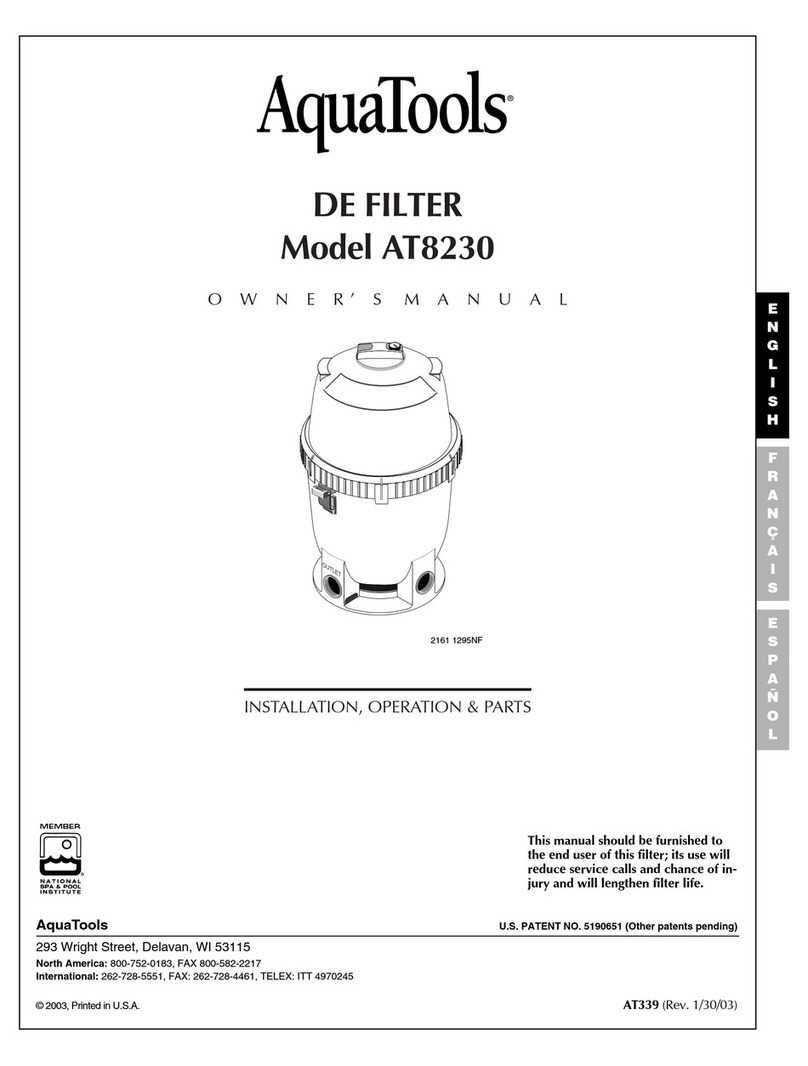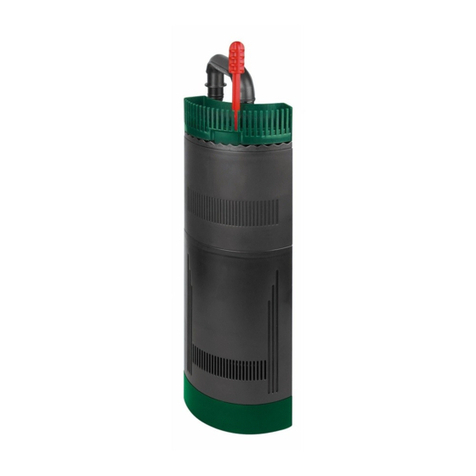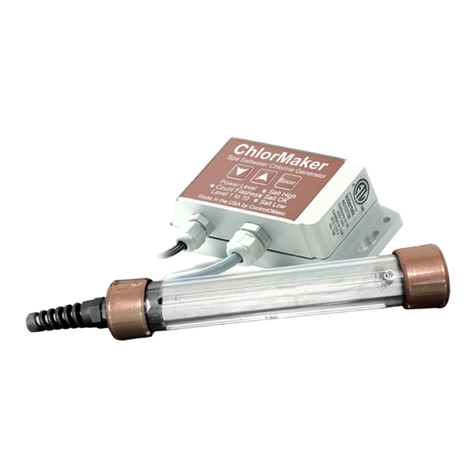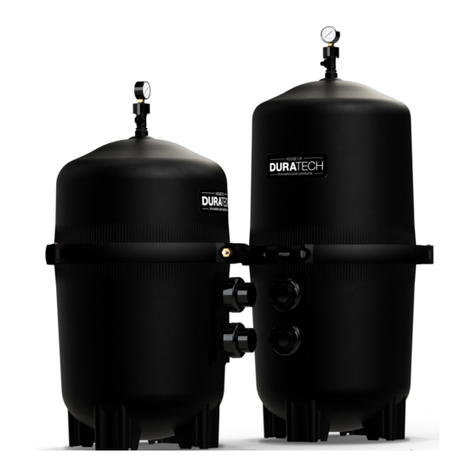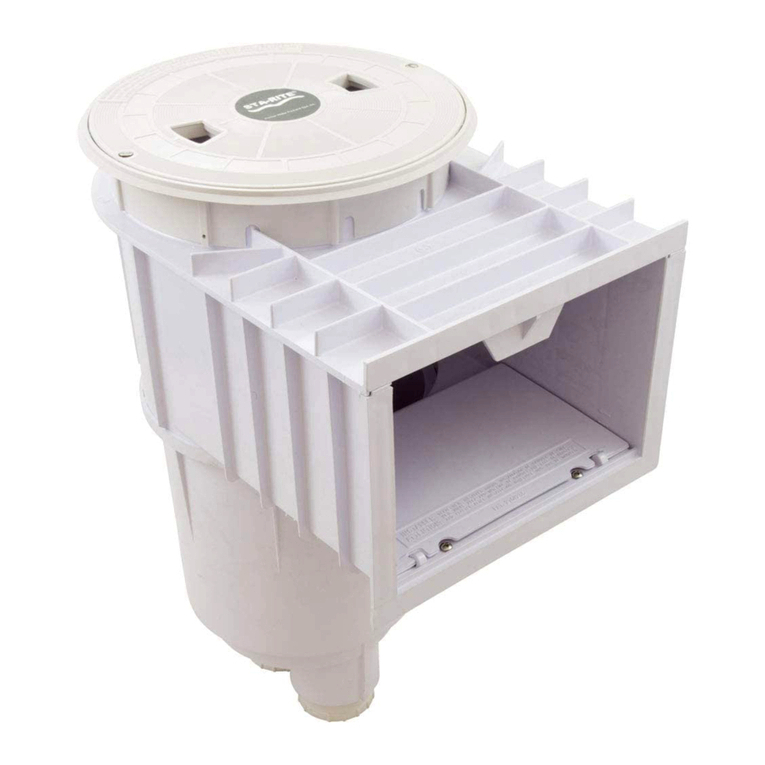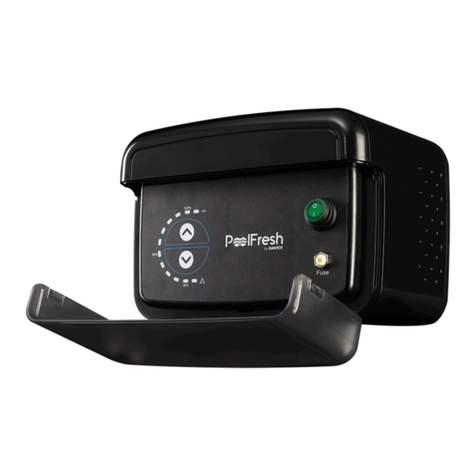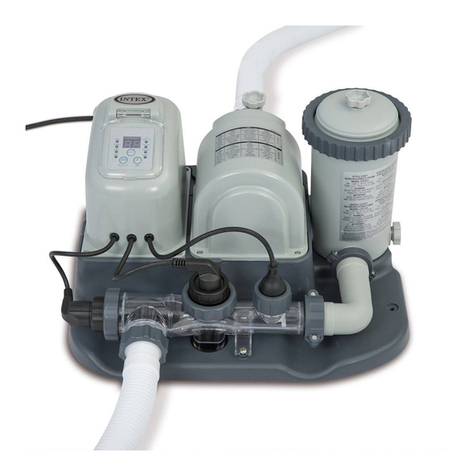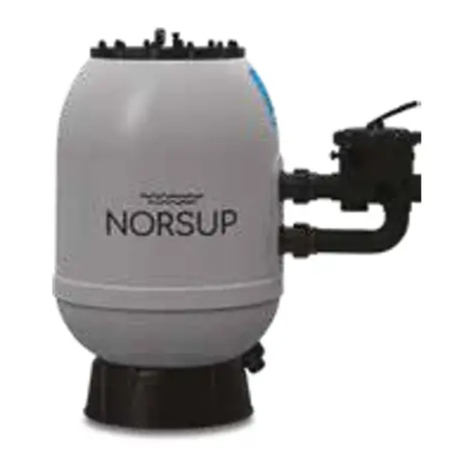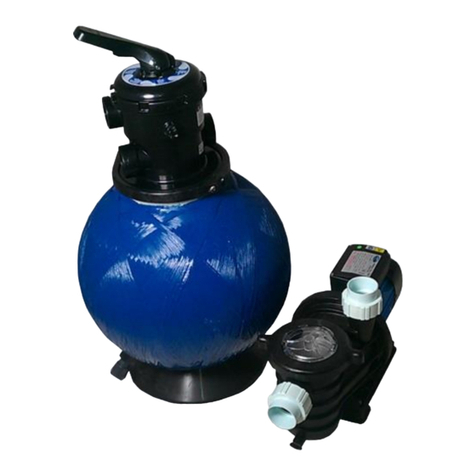Floatron Solar Powered Pool Purifier User manual

OPERATING MANUAL
withcomprehensiveinstructionson:
Initial assembly
Starting up
Ion Testing
What to do in the first few weeks
Electrode Cleaning and Replacment
Maintenance
Closing your pool down and reopening
Operational Checks
Dos and Donts
www.floatron-sa.co.za
Please feel free to contact Frances or Justin on
+27 78 549 8268 or +27 83 657 6520
www.floatron-sa.co.za [email protected]
DOS AND DONTS
Do not automatically take advice for granted from those who are not
experienced with the!floatron. This type of expert opinion is often influenced by
the desire to sell or use chlorine and related pool chemicals, additionally,
recommendations more often than not reflect a chlorine based pool chemistry,
and are not applicable to ionized water.
Do not add any clarifiers or metal removers which will eliminate the beneficial
mineral ions generated by your!floatron.
Do not use with Baquacil or Soft Swim brand products, or others with similar
chemistry. These chemicals must be removed from the water first.
Addition of algaecide is unnecessary as the!floatron!is an algaecide generator.
'Shocking' ionized mineral water is poor technique. It's like an atomic bomb to the
water. The water should be finessed. Oxidizer should be added at reduced
dosages to clarify cloudy water.
START ENJOYING CRYSTAL CLEAR SWIMMING POOL WATER
FOR YOU AND YOUR FAMILY!

WHATS IN THE BOX:
•OPERATING INSTRUCTIONS
•CIRCULAR SOLAR PANEL UNIT
•SPRING ELECTRODE
•MINERAL ELECTRODE
•SCREEN BASKET
•THUMBCREW
•ION TEST KIT
INITIAL ASSEMBLY:
Upon receipt of your!floatron, unpack all of the contents, being sure to look inside the box
for parts. PLEASE Read all instructions before proceeding.
1. Firstly Inspect the solar panel for any visual damage or imperfections which may have
occurred during shipping. If any discrepancies are noticed, contact your dealer or
Floatron customer service.
2. Lay the unit face down on a smooth surface.
3. With one hand, hold the spring electrode down in a compressed condition to avoid
interference.
4. Thread either end of the mineral electrode clockwise onto the silver metal screw stud
at the center of the unit, which is also at the center of the spring electrode.
5. Tighten snugly by hand, about a quarter turn after contact with the black rubber seal
at the base.
6. Lay end cap / spacer onto end of mineral electrode and inside of spring.
7. Place screen cage over electrodes and line up centered holes with the threaded
bore in the mineral electrode end.
8. Thread the black thumbscrew clockwise into the electrode and tighten finger tight, or
snugly. Do not over tighten as the plastic thumbscrew will strip or break if over-
tightened.
NOTES!
The spring electrode is permanently installed and is not removable. Do not attempt
removal by twisting or pulling. Permanent deformation may result.
Save your original box and inserts for safe and convenient storage during the off -
season.
The purpose of the screen cage is to trap any deposits which may form on the
electrodes during normal operation. The screen prevents any particles from falling into
the water.
Your!floatron!is now ready for the water, but your water may not be ready for the!floatron.
Please read on................
STARTING UP:
The floatron will protect your pool against microorganism invasion. Its solar ionization
process transforms your water into biologically healthy and algae resistant mineral
water. Depending on the volume of water, weather conditions, and usage, the
initialization period will range from about a week to several weeks. The floatron cannot
ionize a pool instantly because it is designed as a trickle charger with a safe and
effective low power output. Therefore, it is important to maintain a normal sanitizer
level during this initialization period until the ion concentration reaches a protective
level.
1. Begin with normally chlorinated water, and normal pH for your pool. Use your
regular chlorine test kit to maintain approximately 1.0 ppm (Parts Per Million)
chlorine residual. More chlorine may be necessary if conditions warrant.
2. Clear the water prior to floating your floatron. If your water is less than clear, it
may require a 'shock' dose of oxidizer / chlorine.
3. Check for presence of copper ions in the water with the ion test kit. See 'ION
TESTING'. The typical reading at this point is zero to trace amount (.0 - .1 ppm).
If higher concentrations are detected, this is usually caused by the previous
addition of a copper based algaecide, if so, manage as outlined under 'ION
TESTING' chapter.
4. Free float while ensuring direct sunlight on the unit. If necessary, tether in a
sunny part of the pool any suitable restraint may be tied to the tethering chain
for this purpose.
5. Operate pump and filter system during daylight hours when your floatron is
generating ions. This will allow proper mixing and circulation of the minerals.
Pump operation is unnecessary and optional at night, and the unit can be left
in the pool overnight.

ION TESTING
The mineral electrode is made of a unique alloy of several specific metals,
predominantly copper. The ion test kit detects the presence of the copper ion,
thereby enabling you to determine if the water has an adequate level of
protective minerals. The reagents in the kit are very sensitive, and readings can be
affected by various interferences. Accordingly, use the ion test as a basic and
general indicator. Test only once a week; more often is unnecessary.!
1. Read ion test kit instructions on the test kit.
2. Weekly checks should show an increasing concentration over time.
3. The target is .3 ppm, which upon reaching, chlorine reduction may begin.
4. If the ion reading climbs to .5 ppm or more, remove the unit from the
water for a week and monitor ion level (weekly).
5. Once the level drops to .3 ppm or less, resume floating the unit and
continue weekly ion checks.
6. If the ion level maintains at .3 ppm, then continue floating full time.
The purpose of ion testing is to initially determine that it is safe to reduce chlorine,
and subsequently to establish a floating schedule which results in a steady ion
reading of approximately .3 ppm. Depending on conditions, pools with 20,000
gallons or more usually require full time floating. Smaller pools will usually maintain
an adequate ion level with a part time floating schedule. For example, one day
in, one day out, two days in, one day out, one week in, one week out, etc. Pools
with screened enclosures will probably require full time floating as the output will
be about half of that with normal full sun.
THE FIRST FEW WEEKS
During this period you should witness the ion level build up to approximately .3
ppm. Float the unit daily and do not reduce the floating schedule unless the ion
level tends to climb too high. Remember, more ions are not better. The water has a
capacity to hold only a certain amount of minerals, and attempting to exceed
what is known as 'saturation point' may result in minerals collecting on pool
surfaces. It is important to spend a few minutes a week to check the ion level and
to keep the electrodes clean (see 'ELECTRODE CLEANING').!
1. Upon reaching the recommended ion level of .3 PPM, initiate chlorine
reduction by allowing the chlorine concentration to drop to about half of
its normal level, or approximately .5 ppm.
2. The pH range may now be expanded from 7.2 - 7.8. The Floatron works well
at higher pH values, so do not arbitrarily attempt to adjust the pH if it is
within this recommended range. Keep in mind that the general idea is to
use your Floatron just enough to maintain an adequate ion level, and to
determine how little chlorine is necessary to keep the water clear. Allow
the water to settle down and seek its own balanced condition.
3. Clean electrodes weekly.

ELECTRODE CLEANING
The!floatron!is the only purifier which, in addition to generating beneficial mineral
ions, collects undesirable minerals such as calcium and iron. This has the effect of
softening your water. The sacrificial mineral electrode is designed to slowly erode
away, and in the process will form a scale build up which will require occasional
cleaning. The spring electrode may also form a scale, which normally consists of
calcium, and should also be cleaned. The initial rate of buildup will be quicker in
harder water, and will slow as the water becomes progressively softened. Heavily
scaled electrodes will restrict electrical flow and slow the ionization process,
therefore it is advantageous to clean them on a weekly basis:!
1. Lay unit face down, preferably on grass.
2. Remove thumbscrew, screen, and endcap.
3. Blast with a jet of water from garden hose nozzle, from different directions,
to knock off loose material and scale.
4. Reduce the water flow, and with water running over the electrodes,
attack buildup with cleaning brush to remove most of the remainder of
residues,!
The center electrode need not be cleaned down to bare metal, although the
spring is relatively easy to clean completely. If the majority of the scale is removed,
the!floatron!will perform satisfactorily. It is not possible to clean the electrodes too
much or too often. The cleaner the electrodes, the more efficient the operation.
Occasionally, the screen will require cleaning to ensure a free flow of water and
ion exchange. Because the mesh is very fine, deposits can slowly choke the
openings in the screen and restrict water flow. To clean the white mesh screen:!
1. Hose out loose debris.
2. Immerse screen in a jar of vinegar until visually free of blue / white scale
buildup OR mix about 1/3 Muratic acid/Hydrochloric acid to 2/3 water
and place basket into the jar containing the mixture. The cleaning process
will take a minute or less. Do not expose basket to the acid mix for more
than a minute.
3. Rinse basket and reinstall on floater
MAINTENANCE
It is important to spend a few minutes a week to monitor the water balance, clean
the unit, and to learn the trends. After a couple of months of experience, you
should have a good idea about how little chlorine or oxidizer, is required, how
much floating time does the job, the best way and frequency to clean the
electrodes, etc.!
The!floatron!works well with trace chlorine, or any other oxidizer of your choice.
Algaecides, conditioners, clarifies, etc., etc., are unnecessary. Higher chlorine levels
may be required with an increase in water temperature, increased swimmer load,
rainfall, or new water added. If using liquid chlorine, add at or after sundown
because the sun's rays quickly neutralize chlorine. The recommended levels are not
absolute and may vary with changing water conditions. What works best for your
pool is determined by experience. Allow your water to seek its own balance. Do
not arbitrarily alter the pH, apply large doses of chlorine (AKA 'Shock'), add
algaecide, add conditioner, or try to change perfectly clear water. Give your pool
water time to stabilize, and remember, SIMPLICITY IS THE KEY.
ELECTRODE REPLACMENT
The mineral electrode is sacrificial and design to slowly disintegrate. After an
average of 12 - 24 months, depending on conditions, the electrode will wear
away and require replacement. You will know this when it is 'pencil thin', or about
1/4 inch at its thinnest point. To remove the spent electrode:!
1. Remove screen and endcap, and clean parts.
2. While compressing spring electrode with one hand, rotate center
electrode counterclockwise. If necessary, use pliers for leverage.
3. Continue to unthread until free.
The procedure for installing the electrode is in reverse order, and can be found
under 'INITIAL ASSEMBLY'.!
NOTE: Always keep the same end of the electrode to the floater. Do not swap
ends when removing and replacing your electrode.

CLOSING AND REOPENING YOUR POOL
Whether closing for the winter or for vacation, your pool water should remain clear
for months if you prepare the pool correctly:!
1. Ensure ion reading .3 to .5 ppm. The mineralized water will protect
against algae; the ions act as an algaecide, therefore no need to add
additional algaecide.
2. Turn off all equipment, including pumps, chlorinators, etc.
3. If the water is clear, no need to oxidize. If less than clear, add chlorine /
oxidizer.
4. Remove!floatron
5. Drain water, winterize pumps, cover, etc. as desired.
6. Clean and remove electrode from the unit and store in an airtight
plastic bag or jar.
7. Store your!floatron!indoors. Avoid very cold temperatures.
If the pool was shut down with an insufficient ion level, or severe conditions were
encountered late in the off season, less than clear water conditions may be
experienced. Upon opening:!
1. Top off water level, backwash, and vacuum as necessary.
2. Add chlorine to clear any cloudiness, if present.
3. Test ion level. Float unit to reestablish .3 ppm.
4. If ion level is below .3 ppm, Temporarily increase chlorine for protection.
5. Maintain enough oxidizer to ensure water clarity.
6. Verify pH is within 7.2 - 7.8 Range. Correct if necessary.
OPERATIONAL CHECKS
It is highly unlikely that your!floatron!will not generate ions. Should there be any
doubt, the following quick check will visually prove electrical generation:!
1. Fill a clear, glass or plastic, quart sized jar or equivalent with pool or tap
water.
2. Clean electrodes and leave screen off.
3. Place the!floatron!on the top of the jar, resting on the lip, with the electrodes
immersed in the water.
4. With a full sun shining on the solar panel, very fine bubbles will be observed
after a few seconds originating from the spring coils. This demonstrates that
electrical current is being generated. Absence of bubbles indicates a
problem.
TIPS
•If acid is used for cleaning purposes it may be poured back into pool.
•Allow new plaster type finishes to cure for a month prior to using the!floatron.
•Baking soda works well to raise pH, and is readily available and reasonably
priced.
•Household bleach works excellently for small and medium sized pools. For large
pools, too many gallons may be required, making more concentrated forms of
chlorine more convenient.
•Keep a tablet of chlorine in the skimmer, or floating dispenser, to provide a
constant input of oxidizer into the pool. When necessary, ad an additional
boost of liquid or granulated chlorine to maintain clear water.
•A toothbrush helps in electrode and screen cleaning.
•A cutoff golf tee can be used to secure the screen if the thumbscrew is lost.
•Store chlorine in a cool and dark place.
•Keep ion test kit in refrigerator.
•Check water hardness, measured as total dissolved solids (TDS) at your local
pool store. Readings of approximately 2000 PPM or greater indicate the need
to drain and refill with refresh water. If that is not possible, partial draining and
refilling is beneficial. With a high TDS, the water cannot absorb and retain
minerals very easily.
•The addition of cyanuric acid (stabilizer) is not necessary if you already use a
stabilized form of chlorine, such as tablets.
•The!floatron!can also work well with a pool cover. The choices are to open the
cover enough to float the unit, or cut a 3 inch "X" into the cover which allows
the electrodes to remain in the water while the top is exposed to the sun.
•Clear, high quality water without algae, and an abnormally low ion reading,
does not necessarily indicate that your!floatron!is not functioning properly, in
this situation, call the factory.
•When replacing the mineral electrode, ensure that the threads are dry and free
of water.
•In hard water conditions, over time, the solar panel may form calcium deposits
which are left by water evaporation. To quickly and easily remove the scale,
apply diluted acid / water (as described under 'ELECTRODE CLEANING') with a
toothbrush. Allow to dissolve deposits and rinse. Vinegar may be used although
more time will be required to do the job.
Table of contents
Popular Swimming Pool Filter manuals by other brands

Hayward
Hayward Pro Series Plus owner's manual
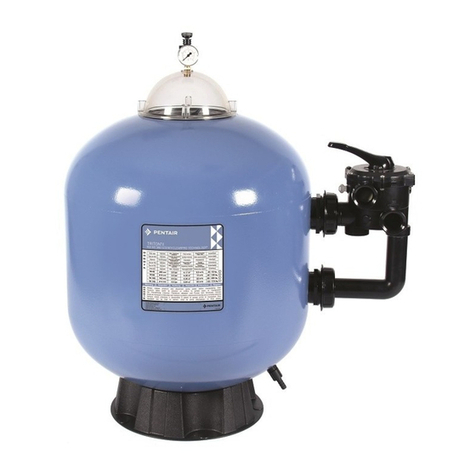
Pentair
Pentair TRITON Installation and user guide
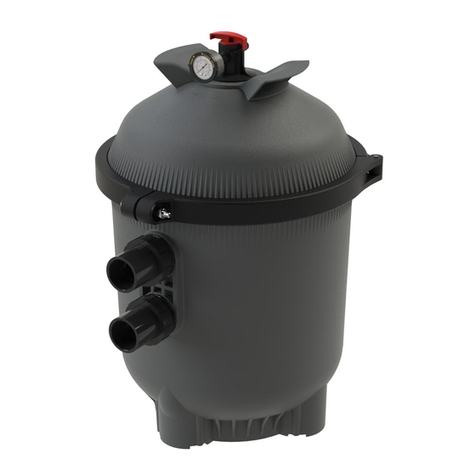
emaux
emaux ICF 230 Installation & operation
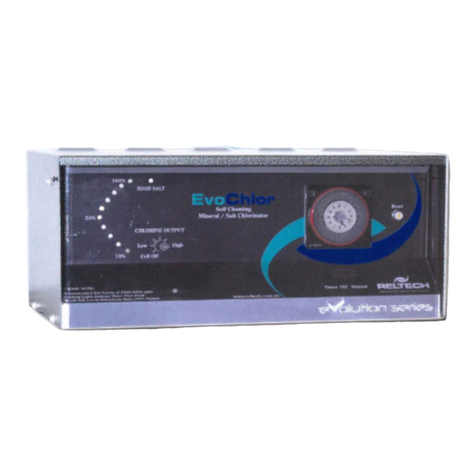
Reltech
Reltech EVOCHLOR EV15 Installation and operation manual

Pentair Pool Products
Pentair Pool Products D.E. Cartridge Style Filter Quad D.E. Installation and user guide
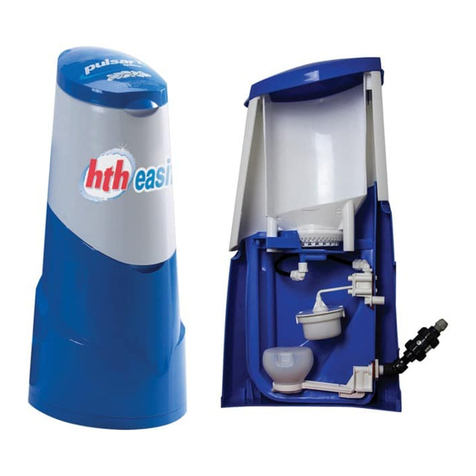
Arch
Arch hth easiflo 1 75876 Operator's manual
